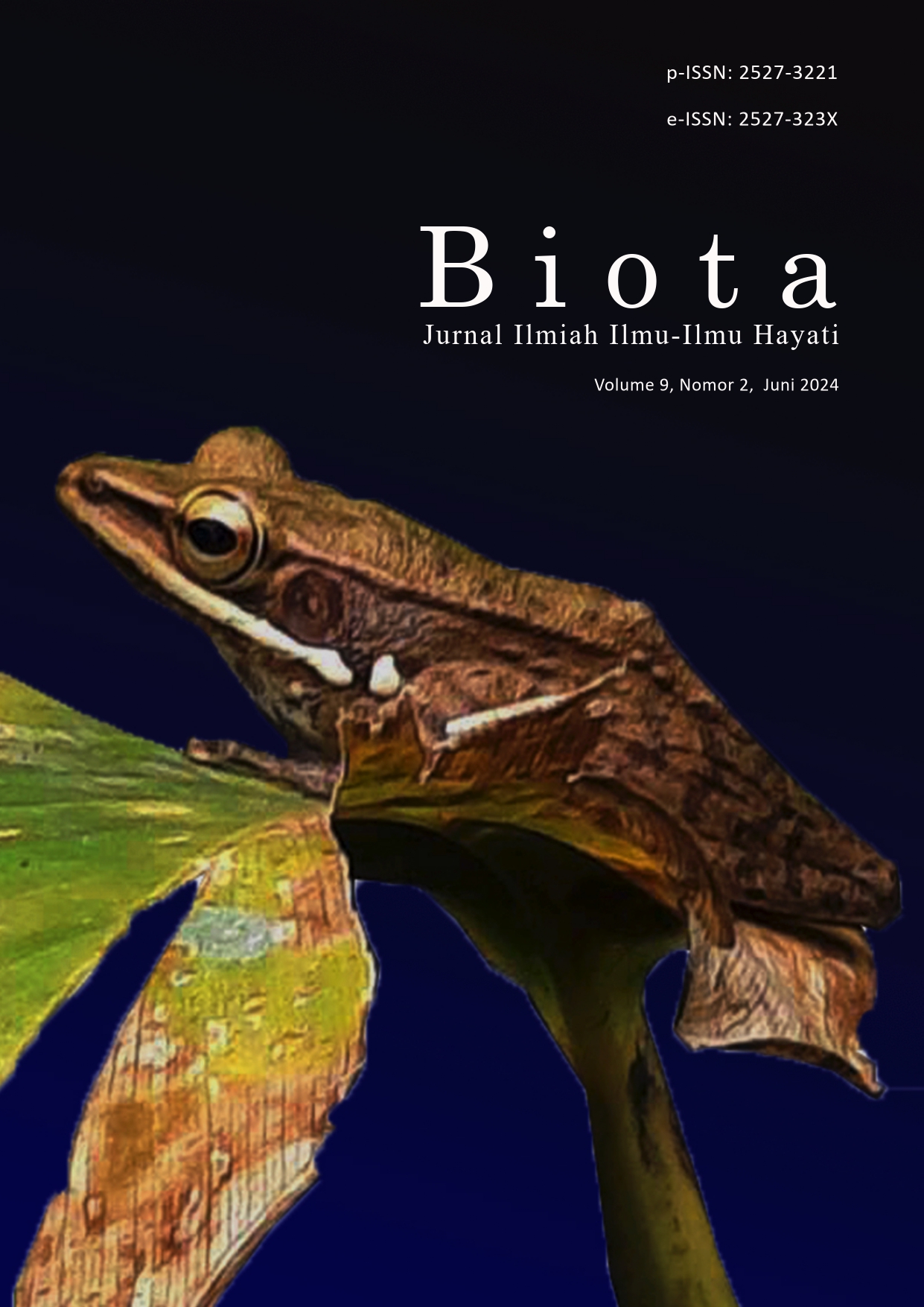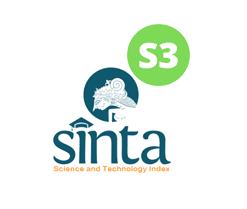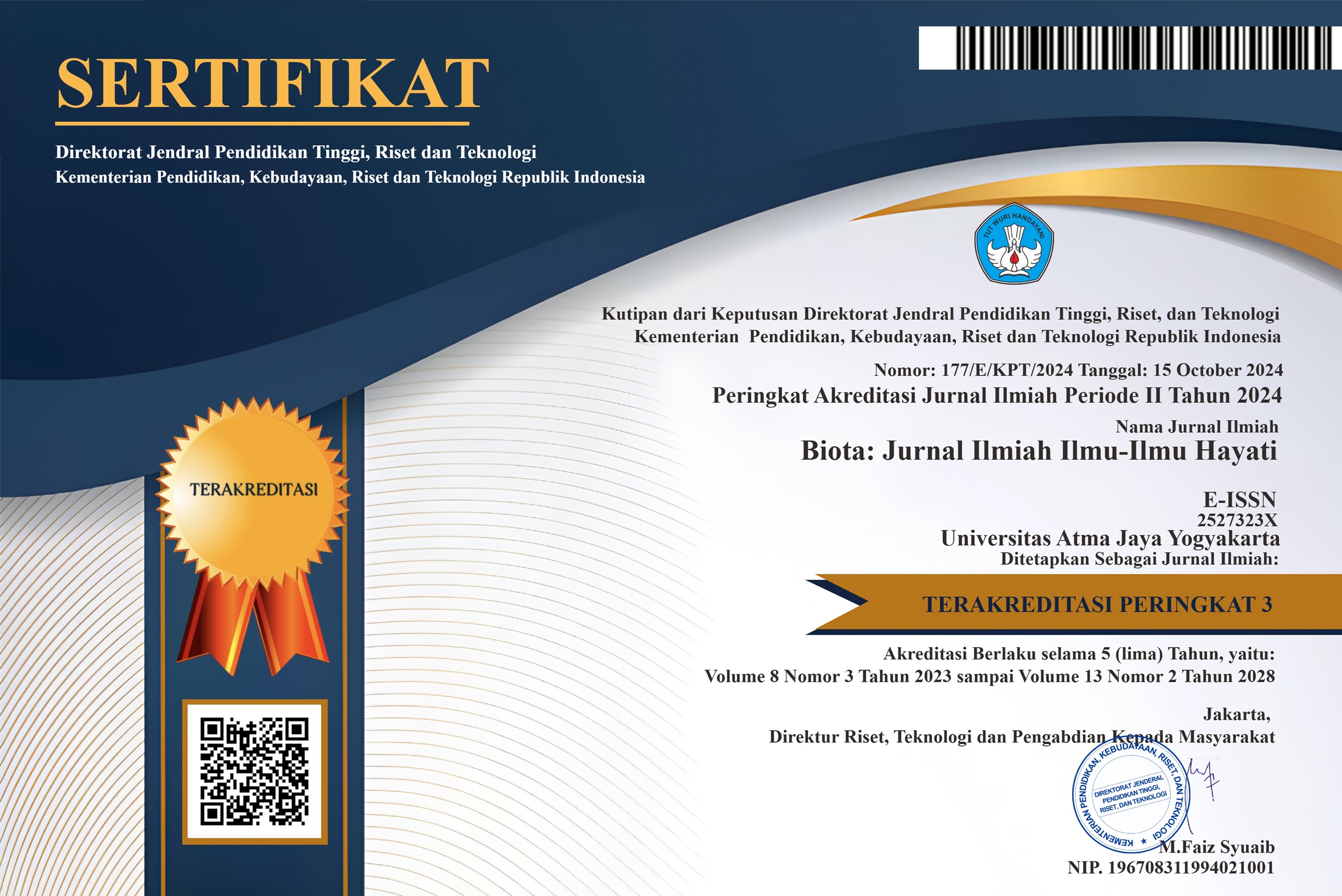Karakterisasi Molekuler Tumbuhan Sidingin (Kalanchoe sp.) Asal Riau Menggunakan Empat Penanda Barkode DNA
DOI:
https://doi.org/10.24002/biota.v9i2.7313Keywords:
Barkode DNA, ITS, Kalanchoe sp., rpl16 intron, trnL-trnL-trnF IGSAbstract
Sidingin (Kalanchoe sp.) merupakan tumbuhan sukulen dari famili Crassulaceae yang tumbuh liar namun memiliki beberapa manfaat sebagai tumbuhan obat. Sidingin asal Riau belum dapat ditentukan nama spesiesnya. Penentuan nama spesies tumbuhan dapat dilakukan menggunakan beberapa barkode DNA, seperti matK, rbcL, dan ITS. Penelitian barkoding DNA pada sidingin asal Riau belum pernah dilakukan. Penelitian ini bertujuan menganalisis empat barkode DNA pada tumbuhan sidingin (Kalanchoe sp.) asal Riau, yaitu ITS, trnL-trnL-trnF intergenic spacer (IGS), ndhC-trnV IGS, dan rpl16 intron. Pada penelitian ini telah diperoleh sekuens DNA untuk ITS, trnL-trnL-trnF IGS, ndhC-trnV IGS, dan rpl16 intron dengan panjang basa secara berturut-turut 662 pb, 909 pb, 949 pb, dan 944 pb. Keempatnya telah didaftarkan dengan nomor registrasi, secara berturut-turut, MW297180, MW297177, MW297178, dan MW297179. Komposisi nukleotida pada ITS berbeda dengan ketiga barkode DNA lainnya. Tidak ada aksesi di GenBank yang memiliki kemiripan 100% dengan sidingin sehingga nama spesies dari sidingin belum dapat ditentukan. Variasi nukleotida paling sedikit dijumpai pada daerah trnL-trnL-trnF IGS (9,65%) dengan jumlah mutasi subtitusi dan indels relatif mirip. Namun uniknya, nukleotida kritis yang merupakan nukleotida penciri paling banyak dijumpai pada daerah trnL-trnL-trnF IGS (1,41%). Kesimpulan, barkode DNA trnL-trnL-trnF IGS dapat digunakan untuk mengidentifikasi tumbuhan sidingin dibandingkan ketiga sekuens lainnya yang diteliti.
References
Blair, C. (2023). Organellar DNA continues to provide a rich source of information in the genomics era. Molecular Ecology 32: 2144– 2150.
Britannica, T. Editors of Encyclopaedia (diakses 18 Mei 2023). Crassulaceae. Encyclopedia Britannica. https://www.britannica.com/plant/Crassulaceae
Cetiz, M. V., Turumtay, E. A., Burnaz, N. A., Özhatay, F. N., Kaya, E., Memon, A. & Turumtay, H. (2023) Phylogenetic analysis based on the ITS, matK and rbcL DNA barcodes and comparison of chemical contents of twelve Paeonia taxa in Türkiye. Molecular Biology Reports 50(6): 5195-5208.
DeSalle, R. & Goldstein, P. (2019), Review and interpretation of trends in DNA barcoding. Frontiers in Ecology and Evolution 7:302.
Fernandes, J.M., Cunha, L.M., Azevedo, E.P., Lourenço, E.M.G., Fernandes-Pedrosa, M.F. & Zucolotto, S.M. (2019). Kalanchoe laciniata and Bryophyllum pinnatum: An updated review about ethnopharmacology, phytochemistry, pharmacology and toxicology. Braz. Revista Brasileira de Farmacognosia 29(4): 529–558.
Kahraman, M. U., Mendi, Y. Y., Karabiyik, S., Lutken, H. V. & Favero, B. T. (2022). Kalanchoe breeding: past, present and future. Ornamental Horticulture 28(1): 19-35.
Kim, K.-R., Park, S.Y., Kim, H., Hong, J.M., Kim, S.-Y. & Yu, J.-N. (2023). Complete chloroplast genome determination of Ranunculus sceleratus from Republic of Korea (Ranunculaceae) and comparative chloroplast genomes of the members of the Ranunculus genus. Genes 14(6): 1149.
Li, C., Zhao, Y., Xu, Z., Yang, G., Peng, J. & Peng, X. (2020). Initial Characterization of the Chloroplast genome of Vicia sepium, an important wild resource plant, and related inferences about its evolution. Frontiers in Genetics 11:73.
Osman, S. A. (2024). The power of DNA barcoding for plant identification. Egyptian Journal of Chemistry 67(1): 633-646.
Purwatiningsih, E. & Lestari, D. (2020). Uji aktivitas antibakteri ekstrak daun cocor bebek (Kalanchoe pinnata (Lam)) terhadap pertumbuhan bakteri Salmonella typhi dengan metode Kirby Bauer. Jurnal Ilmiah Kesehatan 12(2): 142-148.
Putra, Y.O. 2021. Analisis Sekuens Barkode DNA pada Daerah rpl16 Intron Tumbuhan Cocor Bebek [Skripsi]. Universitas Riau.
Roslim, D. I., Herman, Adiwirman & Lestari, W. (2023a). Barkoding DNA (Jilid 1). Penerbit Karya Makmur. Yogyakarta.
Roslim, D. I., Herman, Putri, S. R., Furqoni, A. T., Budiono, D. Y. F., Altuhaish, A. A. F. & Lestari, W. (2023b). Verification of maman (Cleome gynandra (L.) Briq.) from Riau based on matK and trnL-trnL-trnF intergenic spacer. Biosaintifika: Journal of Biology & Biology Education 15(3): 296-305.
Roslim, D. I., Putra, Y. O., Dewi, Y. M., Bago, Y., Sitohang, H., Herman, Fitmawati & Sofiyanti, N. (2021). First record of five DNA barcodes on nothospecies cocor bebek (Kalanchoe × laetivirens). SABRAO Journal of Breeding and Genetics 53(2): 263-377.
Sáez-Vásquez, J. & Delseny, M. (2019). Ribosome biogenesis in plants: from functional 45S ribosomal DNA organization to ribosome assembly factors. The Plant Cell 31(9): 1945–1967.
Xu, Y., Liu, Y., Yu, Z. & Jia, X. (2023). Complete chloroplast genome sequence of the long blooming cultivar Camellia ‘Xiari Qixin’: Genome features, comparative and phylogenetic analysis. Genes 14(2): 460-473.
Wang, X., Xue, J., Zhang, Y., Xie, H., Wang, Y., Weng, W., Kang, Y. & Huang, J. (2020). DNA barcodes for the identification of Stephania (Menispermaceae) species. Molecular Biology Reports 47(3): 2197-2203.
Yuan, L., Tan, G., Zhang, W., Xue, B., Deng, J., Liu, L., & Yao G. (2022). Molecular and morphological evidence for a new species of Pogostemon (Lamiaceae) from Hainan Island, China. PhytoKeys 188: 177-191.
Zhu, S., Liu, Q., Qiu, S., Dai, J. & Gao, X. (2022). DNA barcoding: an efficient technology to authenticate plant species of traditional Chinese medicine and recent advances. Chinese Medicine 17: 112.
Downloads
Published
How to Cite
Issue
Section
License
Copyright (c) 2024 Herman

This work is licensed under a Creative Commons Attribution-NonCommercial 4.0 International License.
Authors who publish with Biota : Jurnal Ilmiah Ilmu-Ilmu Hayati agree to the following terms:
- Authors retain copyright and grant the Biota : Jurnal Ilmiah Ilmu-Ilmu Hayati right of first publication. Licensed under a Creative Commons Attribution-NonCommercial 4.0 International License that allows others to share the work with an acknowledgment of the work's authorship and initial publication in this journal.
- Authors are able to enter into separate, additional contractual arrangements for the non-exclusive distribution of the journal's published version of the work (e.g., post it to an institutional repository or publish it in a book), with an acknowledgment of its initial publication in Biota : Jurnal Ilmiah Ilmu-Ilmu Hayati, and as long as Author is not used for commercial purposes.













